The Castellated Rhombicosidodecahedral Prism
The castellated rhombicosidodecahedral prism is a CRF polychoron bounded by 96 cells (2 rhombicosidodecahedra, 24 pentagonal pyramids, 40 tetrahedra, 30 bilunabirotundae), 424 polygons (280 triangles, 60 squares, 84 pentagons), 492 edges, and 164 vertices.
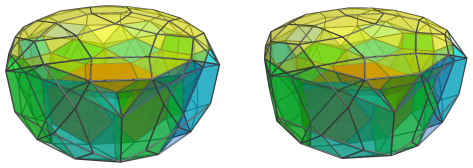
This is the first known non-trivial CRF polychoron that contains the Johnson solid bilunabirotunda (J91) as cells. Prior to its discovery, polytopes containing unusual Johnson solids near the end of Norman Johnson's list, such as J91, were thought to be unlikely to close up in a CRF way. This idea was overturned on February 4, 2014, when the castellated rhombicosidodecahedral prism was constructed and verified to be CRF. This landmark discovery led to the subsequent discovery of numerous other CRF polychora that contain bilunabirotundae and triangular hebesphenorotundae as cells.
Structure
We shall explore the structure of the castellated rhombicosidodecahedral prism using its parallel projections into 3D.
Centered on Rhombicosidodecahedron
The Near Side
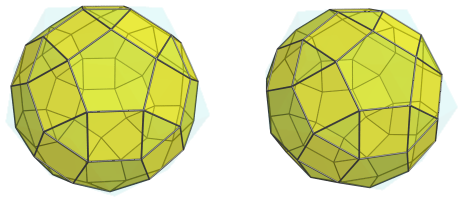
The above image shows the nearest rhombicosidodecahedral cell to the 4D viewpoint. For clarity, all other cells are rendered in a light transparent color.
This cell forms the top of the castellated prism. Its triangular faces are joined to 20 tetrahedral cells, shown below:
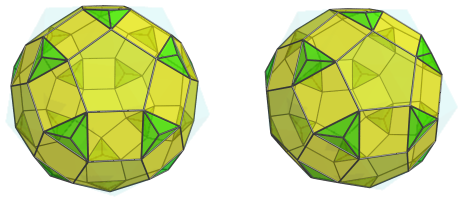
These tetrahedra appear rather flat, because they actually lie at a sharp angle to the rhombicosidodecahedron, and are foreshortened by the parallel projection. In 4D, however, they are perfectly regular tetrahedra.
The pentagonal faces of the rhombicosidodecahedron are joined to 12 pentagonal pyramids:
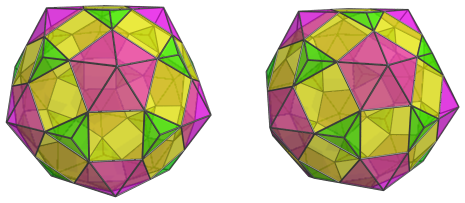
These pentagonal pyramids lie at a shallower angle from the nearest cell, and protrude quite a bit outwards. Notice that their triangular faces appear to be coplanar with the square faces of the rhombicosidodecahedron and the outer triangular faces of the tetrahedra. The projection envelope here is, therefore, a rhombic triacontahedron. In 4D, of course, they are not coplanar; but they appear as such here because this is where these cells connect with the 30 bilunabirotundae, which lie on the limb of the projection, at 90° to the current 4D viewpoint.
The Equator
The next image shows these 30 bilunabirotunda cells:
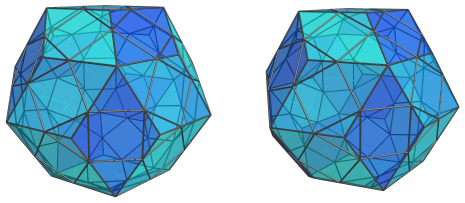
The bilunabirotundae have been foreshortened into rhombuses, because they lie at a 90° angle to the current 4D viewpoint. They are connected to each other via their pentagonal faces, which have been foreshortened here to the edges of the rhombuses.
Past this point, we reach the far side of the castellated rhombicosidodecahedral prism, where there are another 20 tetrahedra, 12 pentagonal pyramids, and the antipodal rhombicosidodecahedron, in an arrangement that mirrors what we saw above.
The following table summarizes the cell counts for the castellated rhombicosidodecahedral prism, as seen from the current 4D viewpoint:
| Region | ||||
|---|---|---|---|---|
| Near side | 1 | 12 | 20 | 0 |
| Equator | 0 | 0 | 0 | 30 |
| Far side | 1 | 12 | 20 | 0 |
| Total | 2 | 24 | 40 | 30 |
Centered on a Bilunabirotunda
The previous projections give us a good overview of the global structure of the castellated rhombicosidodecahedral prism. However, that 4D viewpoint failed to show us the details of the most interesting part of this polychoron: the bilunabirotunda cells, since they lay parallel to the line-of-sight. So now, we look at the castellated prism again from a different viewpoint, this time a side-view centered on one of the bilunabirotundae.
The Near Side
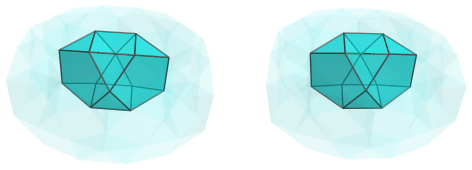
The above image shows the nearest bilunabirotunda to the 4D viewpoint. For the sake of clarity, we have rendered the other cells in a light transparent color.
The pentagonal faces of this cell are joined to 4 other bilunabirotunda, two of which are shown below:
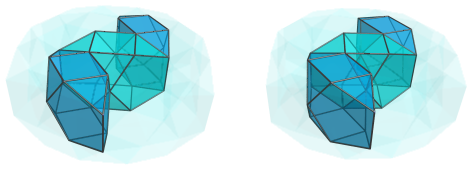
And the other 2 are shown next:
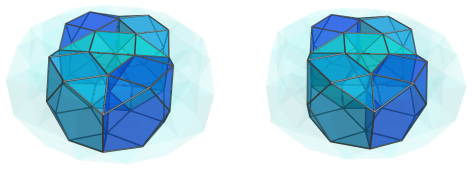
Between the square faces of these cells are 4 tetrahedra, shown below in green:
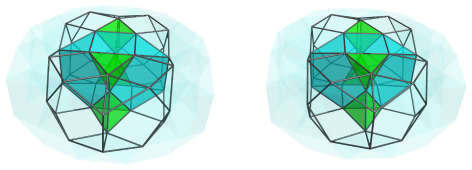
For the sake of clarity, we show the 4 bilunabirotunda around the nearest cell only in outline. These tetrahedra fill up the gaps between the 5 bilunabirotundae.
Here are all the cells so far shown in full:
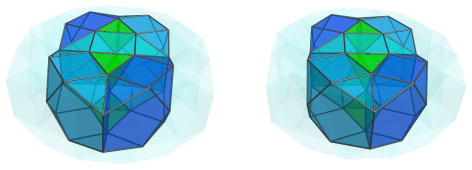
The left and right edges of the nearest bilunabirotunda are connected to yet another two pairs of bilunabirotundae:
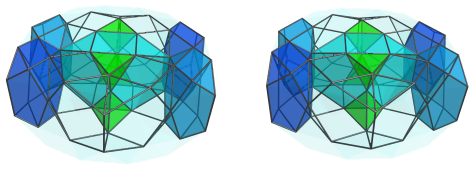
Again, we show the initial 4 bilunabirotundae only in outline, so that the new cells are more clearly seen. Notice that they look somewhat deformed from the usual bilunabirotunda. This is an artifact of the projection; they lie close to the limb of the polytope and are significantly slanting into the fourth direction. In 4D, all the bilunabirotundae are identical.
The pentagonal depressions at the top and bottom of the nearest cell's left and right edges are where 4 pentagonal pyramids are positioned:
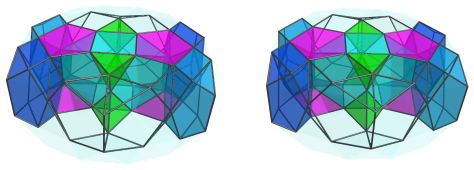
Here are all the cells we've seen so far:
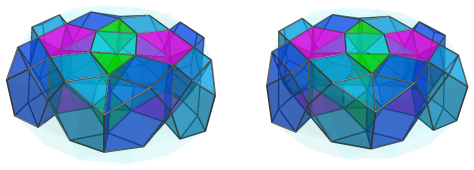
The gaps between the square faces of the 4 new bilunabirotundae and the the previous four are, of course, filled with more tetrahedra: 12 more of them, 6 on top, 6 on the bottom.
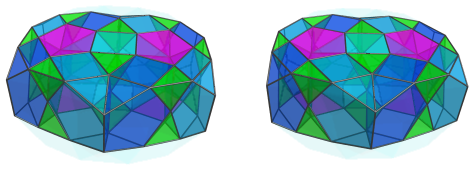
The slight indentations visible in the front of the projection, as well as equivalent indentations in the back (not obvious from this 3D viewpoint), are where 4 more bilunabirotundae are fitted:
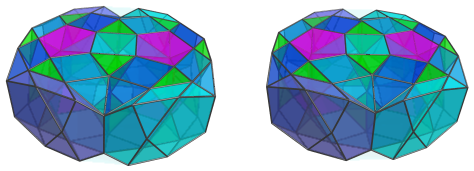
Two more pairs of pentagonal pyramids fit into the gaps at the front and the back of the projection:
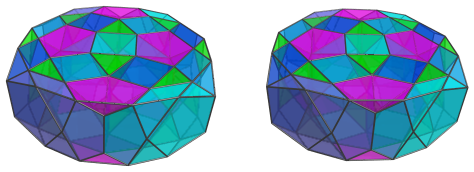
These pentagonal pyramids appear distorted, because they lie close to the limb of the projection and are significantly slanting into the fourth direction. In reality, they are not distorted; this is merely a foreshortening caused by the projection into 3D.
These are all the cells that lie on the near side of the castellated rhombicosidodecahedral prism from this 4D viewpoint. We now come to the limb of the projection where the cells lie at a 90° angle from the 4D viewpoint.
The Limb
There are 4 bilunabirotundae that lie on the limb of the projection; these are shown below:
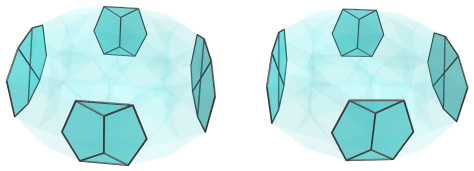
They appear flattened into non-uniform hexagons and octagons, because they lie at a 90° angle from the 4D viewpoint. In reality, they are identical to the other bilunabirotunda cells. The bottom edges of their projection images, which are actually squares, are joined to the bottom rhombicosidodecahedron cell of the polytope:
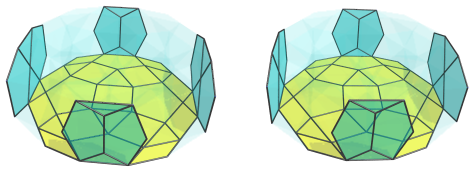
As with the bilunabirotundae, this rhombicosidodecahedron lies at a 90° angle to the 4D viewpoint, so it appears flattened into dodecagon. It is, of course, perfectly uniform in 4D.
Four pentagonal pyramids, shown in magenta below, connect this rhombicosidodecahedron to the two bilunabirotundae on the left and right:
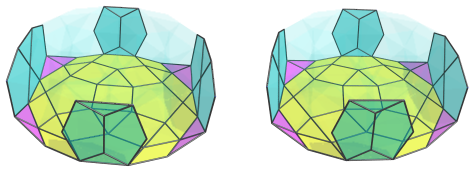
The front and back bilunabirotundae are connected by 4 tetrahedra:
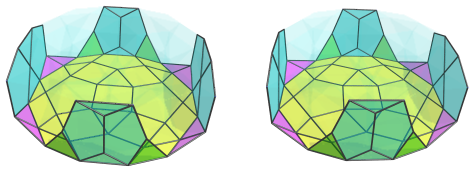
These pentagonal pyramids and tetrahedra, of course, also occur on the top sides of the bilunabirotundae:
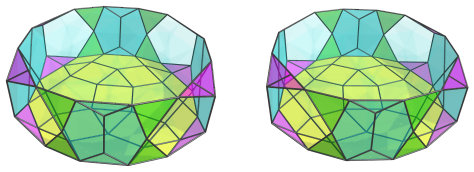
Finally, the other rhombicosidodecahedron appears on the top of the projection:
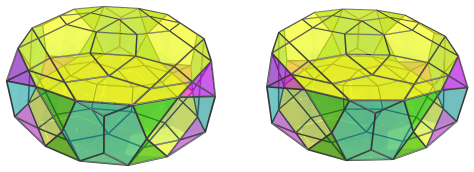
These are all the cells that lie on the limb of the projection. Past this point, we get to the far side of the polytope, where the arrangement of cells exactly mirrors that of the near side. The four remaining pentagonal gaps are not filled by any cells; they are where 4 of the bilunabirotundae on the near side touch their counterparts on the far side.
This 4D viewpoint best shows the prism-like structure of this CRF polychoron. It resembles the rhombicosidodecahedral prism, except that it has protrusions from its side cells that form the band of pentagonal pyramids, tetrahedra, and bilunabirotundae. These protruding pentagonal pyramids and tetrahedra around the rim of the prism-like shape are like battlements of a castle; hence the name castellated rhombicosidodecahedral prism.
Summary
The following table summarizes the cell counts for the castellated rhombicosidodecahedral prism from this 4D viewpoint:
| Region | ||||
|---|---|---|---|---|
| Near side | 0 | 8 | 4 + 12 = 16 | 1 + 4 + 4 + 4 = 13 |
| Limb | 2 | 8 | 8 | 4 |
| Far side | 0 | 8 | 16 | 13 |
| Total | 2 | 24 | 40 | 30 |
Coordinates
The coordinates of the castellated rhombicosidodecahedral prism, centered on the origin with edge length 2, are all changes of sign of:
|
|
where φ=(1+√5)/2 is the Golden Ratio.




